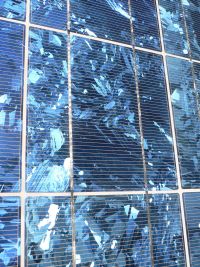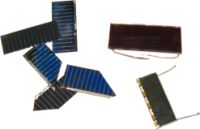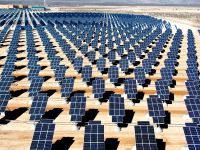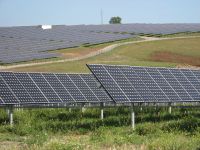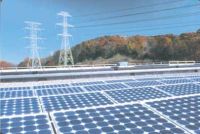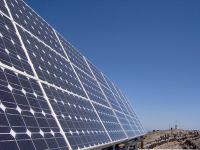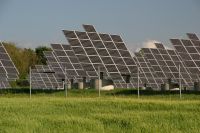Photovoltaic cell
A solar cell or photovoltaic cell is a device that converts sunlight directly into electricity by the photovoltaic effect. Sometimes the term solar cell is reserved for devices intended specifically to capture energy from sunlight, while the term photovoltaic cell is used when the light source is unspecified.
History
The photovoltaic effect was first recognized in 1839 by French physicist A. E. Becquerel. However, it was not until 1883 that the first solar cell was built, by Charles Fritts, who coated the semiconductor selenium with an extremely thin layer of gold to form the junctions. The device was only around 1% efficient. Russell Ohl patented the modern junction semiconductor solar cell in 1946. The modern age of solar power technology arrived in 1954 when Bell Laboratories, experimenting with semiconductors, accidentally found that silicon doped with certain impurities was very sensitive to light.
This resulted in the production of the first practical solar cells with a sunlight energy conversion efficiency of around 6 percent. Early in the seventies, the photovoltaic cells left laboratories and the universe and appeared on the Earth, especially thanks to oil companies from Mexico Gulf. On the automated offshore constructions, electricity is needed for illumination (lighthouse) and for rust protection.
Physical substance of the photovoltaic phenomena was explained by Albert Einstein who was awarded by the Nobel Prize in 1921 for his invention.
Production technology
Technology of thick layers
A photovoltaic cell consists of a large-area semiconductor p-n diode. The cells are manufactured from silicium slices of either mono-crystalline or poly-crystalline silicium. At present, this technology is used for production of +85% solar cells on the market.
Technology of thin layers
A photovoltaic cell consists of a supporting area (e.g. glass, textile etc.) on which very thin layers of amorphous micro-crystalline silicium are steamed. Quantity of material required for production of the thin layer photovoltaic cells is lower and therefore, they are cheaper when compared to the thick layer cells. A disadvantage of current photovoltaic cells is lower efficiency and life cycle.
No silicium-based technologies
Contrary to the previous technologies, traditional P-N semiconductor transition is not used for conversion of light into electric energy. Various organic compounds, polymers etc. are used. However, these technologies are at the beginning of their research.
Considering potential mass application of photovoltaic cells, of which production price would be much lower than today, research and development of photovoltaic cells based on photosensitive materials other than silicium is under way. Conductive polymers are one of the options; e.g. in November 2005, a research group at University of California in Los Angeles achieved maximum efficiency 4.4% for now.
Efficiency
According to theory, a photovoltaic cell may convert max 50% of all incident light into electric energy. In practice, about 15% is achieved in industrially produced cells. Up to 30% efficiency is achieved for the cells produced in laboratories.
For current photovoltaic thin layer cells, approximate efficiency of 8 - 9% is achieved, however it is decreased much faster over the time than for thick layer cells.
In 2006, the US National Renewable Energy Laboratory presented cells with triple transitions of up to 40.7% efficiency.
Energetic pay-back of a solar cell
There is a widespread myth that a photovoltaic cell can not produce as much energy over its life cycle as spent for its production. In fact, a common industrially produced cell in a panel can produce as much as energy required for its production within two to three years, depending on geographical location. For the Czech Republic, an example calculation of EPBT (energy pay-back time) of a cell available on Cz RE Agency website is 3.86 - 5.22 years. With assumed life cycle of the photovoltaic cells equal to 30 years, the cell may produce up to 15 times more energy than consumed for its production.
Photovoltaic systems worldwide
At worldwide level, record 2.8 GWp of photovoltaic cells were installed in 2007.
Most installations of the solar systems are located in industrially developed countries (the USA, Germany, Japan, Switzerland, France, Italy, the Netherlands) and in countries where the installation is supported by governments or international organizations (Spain, Greece, Morocco, Indonesia etc.). 89% of total PV cells are installed in Germany, Japan, and the USA.
Governmental support is now seen in the USA, in the EU member states, Japan and Indonesia. Theories assume that photovoltaic sources should cover in the future about 5÷10% of total electricity consumption of a country or up to 10% worldwide energy consumption as of 2050. The installed power could be increased to 3 GWp in the EU member countries by 2010. This corresponds to total annual worldwide growth of about 580 MWp.
In the Czech Republic
Regarding incidence of sunlight, the Czech Republic is not located in an optimum way, but is has a suitable geographical location for construction of solar power plants. Number speaks. Minimum illuminating power for the territory of the Czech Republic is 950 kWh/m2 and maximum oscillates at about 1,250 - 1,300 kWh/m2. In the Czech Republic, roughly 950 - 1,340 kWh of energy falls down to 1 m2. Annual number of sun hours ranges from 1,331 to 1,844 (Czech Hydrometeorological Institute) and bibliography says average number of hours 1,600 - 2,100. From the practical point of view, one installed kW of common system (PV cells from mono-crystalline or multi-crystalline silicium, normal efficiency of inverters etc.) can yield about 800 - 1,100 kWh of electricity per year.

